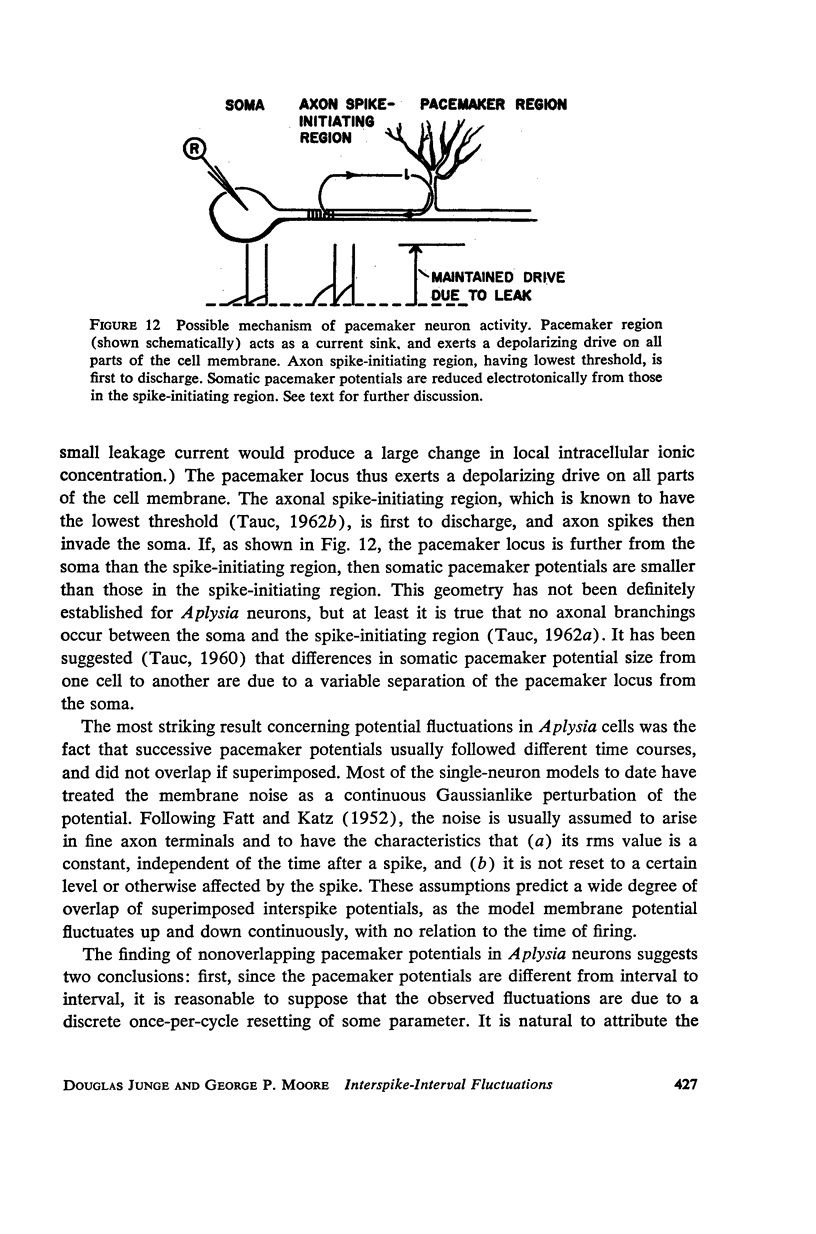Abstract
In recent years, several mathematical models have been put forth to explain the time sequence of spike discharges in single neurons, in terms of synaptic inputs or intrinsic mechanisms. All of these models have been hypothetical, in that intracellular events were assumed, and not measured directly. The purpose of the present work was to study the statistics of the discharge from a preparation where intracellular recording was possible, and relate the observed discharge to measurable cell parameters. Regularly firing “pacemaker neurons” in the visceral ganglion of Aplysia californica were studied, using intracellular stimulating and recording techniques. Measurements were obtained of average curves of membrane potential, threshold for spike initiation, membrane resistance, and fluctuations of potential in the intervals between spontanously occurring spikes. The timing of discharges from these neurons was described quantitatively by interspike-interval histograms, mean and standard deviation of intervals, skewness, and serial correlation coefficients. A mathematical model (contained in a simulation program for the IBM 7094 computer) was constructed, based on discrete fluctuations of membrane potential following each spike and other directly observed intracellular events. It was found that the model could quantitatively account for observed spike trains, including variations in the discharge from one cell to another.
Full text
PDF























Images in this article
Selected References
These references are in PubMed. This may not be the complete list of references from this article.
- ARVANITAKI A., CHALAZONITIS N. Configurations modales de l'activité, propres à différents neurones d'un mëme centre. J Physiol (Paris) 1958 Mar;50(2):122–125. [PubMed] [Google Scholar]
- BISHOP P. O., LEVICK W. R., WILLIAMS W. O. STATISTICAL ANALYSIS OF THE DARK DISCHARGE OF LATERAL GENICULATE NEURONES. J Physiol. 1964 Apr;170:598–612. doi: 10.1113/jphysiol.1964.sp007352. [DOI] [PMC free article] [PubMed] [Google Scholar]
- Buller A. J. A model illustrating some aspects of muscle spindle physiology. J Physiol. 1965 Aug;179(3):402–416. doi: 10.1113/jphysiol.1965.sp007669. [DOI] [PMC free article] [PubMed] [Google Scholar]
- EYZAGUIRRE C., KUFFLER S. W. Processes of excitation in the dendrites and in the soma of single isolated sensory nerve cells of the lobster and crayfish. J Gen Physiol. 1955 Sep 20;39(1):87–119. doi: 10.1085/jgp.39.1.87. [DOI] [PMC free article] [PubMed] [Google Scholar]
- FATT P., KATZ B. Spontaneous subthreshold activity at motor nerve endings. J Physiol. 1952 May;117(1):109–128. [PMC free article] [PubMed] [Google Scholar]
- FESSARD A., TAUC L. Capacité, résistance et variations actives d'impédance d'un soma neuronique. J Physiol (Paris) 1956 May-Jun;48(3):541–544. [PubMed] [Google Scholar]
- FUORTES M. G., MANTEGAZZINI F. Interpretation of the repetitive firing of nerve cells. J Gen Physiol. 1962 Jul;45:1163–1179. doi: 10.1085/jgp.45.6.1163. [DOI] [PMC free article] [PubMed] [Google Scholar]
- GERSTEIN G. L., MANDELBROT B. RANDOM WALK MODELS FOR THE SPIKE ACTIVITY OF A SINGLE NEURON. Biophys J. 1964 Jan;4:41–68. doi: 10.1016/s0006-3495(64)86768-0. [DOI] [PMC free article] [PubMed] [Google Scholar]
- GOLDBERG J. M., ADRIAN H. O., SMITH F. D. RESPONSE OF NEURONS OF THE SUPERIOR OLIVARY COMPLEX OF THE CAT TO ACOUSTIC STIMULI OF LONG DURATION. J Neurophysiol. 1964 Jul;27:706–749. doi: 10.1152/jn.1964.27.4.706. [DOI] [PubMed] [Google Scholar]
- HAGIWARA S. Analysis of interval fluctuation of the sensory nerve impulse. Jpn J Physiol. 1954 Sep 1;4(3):234–240. doi: 10.2170/jjphysiol.4.234. [DOI] [PubMed] [Google Scholar]
- Lewis E. R. Neuroelectric potentials derived from an extended version of Hodgkin-Huxley model. J Theor Biol. 1966 Jan;10(1):125–158. doi: 10.1016/0022-5193(66)90181-0. [DOI] [PubMed] [Google Scholar]
- Moore G. P., Perkel D. H., Segundo J. P. Statistical analysis and functional interpretation of neuronal spike data. Annu Rev Physiol. 1966;28:493–522. doi: 10.1146/annurev.ph.28.030166.002425. [DOI] [PubMed] [Google Scholar]
- Segundo J. P., Perkel D. H., Moore G. P. Spike probability in neurones: influence of temporal structure in the train of synaptic events. Kybernetik. 1966 May;3(2):67–82. doi: 10.1007/BF00299899. [DOI] [PubMed] [Google Scholar]
- TAUC L. Identification of active membrane areas in the giant neuron of Aplysia. J Gen Physiol. 1962 Jul;45:1099–1115. doi: 10.1085/jgp.45.6.1099. [DOI] [PMC free article] [PubMed] [Google Scholar]
- TAUC L. Site of origin and propagation in spike in the giant neuron of Aplysia. J Gen Physiol. 1962 Jul;45:1077–1097. doi: 10.1085/jgp.45.6.1077. [DOI] [PMC free article] [PubMed] [Google Scholar]
- TAUC L. [Diversity of the modes of activity of the nerve cells of the disconnected ganglion of Aplysia]. C R Seances Soc Biol Fil. 1960;154:17–21. [PubMed] [Google Scholar]
- TEN HOOPEN ON AN IMPULSE INTERVAL GENERATING MECHANISM. Jpn J Physiol. 1964 Dec 15;14:607–614. doi: 10.2170/jjphysiol.14.607. [DOI] [PubMed] [Google Scholar]
- WERNER G., MOUNTCASTLE V. B. THE VARIABILITY OF CENTRAL NEURAL ACTIVITY IN A SENSORY SYSTEM, AND ITS IMPLICATIONS FOR THE CENTRAL REFLECTION OF SENSORY EVENTS. J Neurophysiol. 1963 Nov;26:958–977. doi: 10.1152/jn.1963.26.6.958. [DOI] [PubMed] [Google Scholar]




